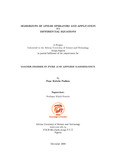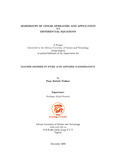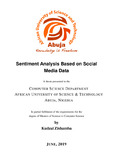Browsing by Title
Now showing items 3778-3797 of 4806
-
Semigroups of Linear Operators and Application to Differential Equations
(2009-12-08)This work concerns one of the most important tools to solve well-posed problems in the theory of evolution equations (e.g di usion equation, wave equations, ...) and in the theory of stochastic process, namely the semigroups ...
-
Semigroups Of Linear Operators And Application To Differential Equations
(2009-12-04)This work concerns one of the most important tools to solve well-posed problems in the the- ory of evolution equations (e.g di usion equation, wave equations, ...) and in the theory of stochastic process, namely the ...
-
Semiotic machines : software in discourse
(University of Cape TownFaculty of ScienceDepartment of Computer Science, 2008)This study develops new theoretical and methodological approaches to the study of software as a medium of communication. This study analyses voting software, educational software, search engines, and combat and narrative ...
-
Senate House Procession, Jan 2005
(2008-02-07)The procession leaving the Senate House at the end of a degree ceremony, led by the Esquire Bedells
-
Sensing in the Mouth: A Model for Filiform Papillae as Strain Amplifiers
(FrontiersFrontiers in Physics, 2016-08-23)Texture perception of foods is a common yet remarkably unstudied biophysical problem. Motivated by recent experiments reporting the presence of corpuscular endings in tongue filiform papillae, we develop in this work a ...
-
Sensing Strategies for Disambiguating Among Multiple Objects in Known Poses
(1985-08-01)The need for intelligent interaction of a robot with its environment frequently requires sensing of the environment. Further, the need for rapid execution requires that the interaction between sensing and action take ...
-
Sensitive Manipulation
(2007-03-02)This thesis presents an effective alternative to the traditionalapproach to robotic manipulation. In our approach, manipulation ismainly guided by tactile feedback as opposed to vision. Themotivation comes from the fact ...
-
Sentiment Analysis Based on Social Media Data
(2019-06-16)Sentiment analysis has proven to be one of the most challenging tasks in natural language processing (NLP). Many AI systems have been developed which can detect the polarity of a sentence (degree of positivity, neutrality ...
-
Separable projection integrals for higher-order correlators of the cosmic microwave sky: Acceleration by factors exceeding 100
(ElsevierJournal of Computational Physics, 2016-01-19)We present a case study describing efforts to optimise and modernise “Modal”, the simulation and analysis pipeline used by the Planck satellite experiment for constraining general non-Gaussian models of the early universe ...
-
Separating Reflections from Images Using Independent Components Analysis
(1998-09-01)The image of an object can vary dramatically depending on lighting, specularities/reflections and shadows. It is often advantageous to separate these incidental variations from the intrinsic aspects of an image. Along these ...
-
Sepia: a Framework for Natural Language Semantics
(2009-05-28)To help explore linguistic semantics in the context of computational natural language understanding, Sepia provides a realization the central theoretical idea of categorial grammar: linking words and phrases to compositional ...
-
Sequence-Seeking and Counter Streams: A Model for Information Processing in the Cortex
(1991-12-01)This paper presents a model for the general flow in the neocortex. The basic process, called "sequence-seeking," is a search for a sequence of mappings or transformations, linking source and target representations. The ...
-
Sequential Optimal Recovery: A Paradigm for Active Learning
(1995-05-12)In most classical frameworks for learning from examples, it is assumed that examples are randomly drawn and presented to the learner. In this paper, we consider the possibility of a more active learner who is allowed ...
-
SEQUINS and QUILLS: Representations for Surface Topography
(1979-05-01)The shape of a continuous surface can be represented by a collection of surface normals. These normals are like a porcupine's quills. Equivalently, one can use the surface patches on which these normals rest. These ...
-
Series Elastic Actuators
(1995-09-07)This thesis presents the design, construction, control and evaluation of a novel force controlled actuator. Traditional force controlled actuators are designed from the premise that "Stiffer is better''. This approach ...
-
Service Identification in TCP/IP: Well-Known versus Random Port Numbers
(2006-01-11)The sixteen-bit well-known port number is often overlooked as a network identifier in Internet communications. Its purpose at the most fundamental level is only to demultiplex flows of traffic. Several unintended uses of ...
-
A Session with TINKER: Interleaving Program Testing with Program Design
(1980-09-01)Tinker is an experimental interactive programming system which integrates program testing with program design. New procedures are created by working out the steps of the procedure in concrete situations. Tinker displays ...
-
Set Interfaces for Generalized Typestate and Data Structure Consistency Verification
(2007-10-31)Typestate systems allow the type of an object to change during its lifetime in the computation. Unlike standard type systems, they can enforce safety properties that depend on changing object states. We present a new, ...
-
Seven lessons from manyfield inflation in random potentials
(IoPJOURNAL OF COSMOLOGY AND ASTROPARTICLE PHYSICS, 2018-01)We study inflation in models with many interacting fields subject to randomly generated scalar potentials. We use methods from non-equilibrium random matrix theory to construct the potentials and an adaption of the ‘transport ...
-
Several applications of a model for dense granular flows
(University of CambridgeDepartment of Applied Mathematics and Theoretical Physics, 2011-03-15)This dissertation describes efforts to evaluate a recently proposed continuum model for the dense flow of dry granular materials (Jop, Forterre & Pouliquen, 2006, Nature, 441, 167-192). The model, based upon a generalisation ...



